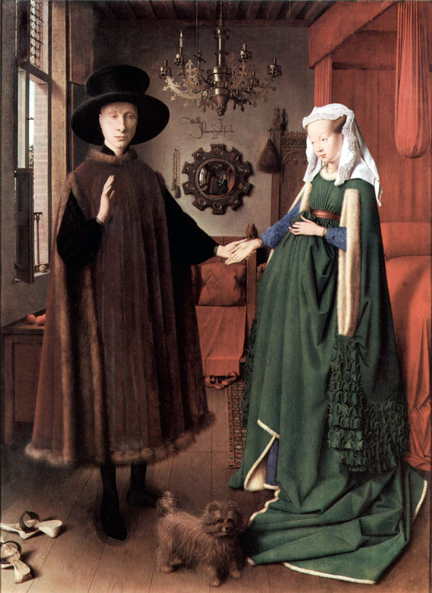 Jan Van Eyck’s 1434 painting of the Arnolfini Marriage is a peach, one of those images that continues to stir up the fire for the love of painting. It’s one of the first truly saturated paintings I know of; brimming with symbolism, Van Eyck jammed every square centimeter of the modestly-sized surface with photo-realistic detail. It’s magnificent now, but was an absolute stunner in its day. No wonder the Duke of Burgundy treated Van Eyck well. You can take a closer look at it here, at the National Gallery’s website.
Jan Van Eyck’s 1434 painting of the Arnolfini Marriage is a peach, one of those images that continues to stir up the fire for the love of painting. It’s one of the first truly saturated paintings I know of; brimming with symbolism, Van Eyck jammed every square centimeter of the modestly-sized surface with photo-realistic detail. It’s magnificent now, but was an absolute stunner in its day. No wonder the Duke of Burgundy treated Van Eyck well. You can take a closer look at it here, at the National Gallery’s website.
I’ve been paying attention to it again, as well as to some of Van Eyck’s other works. From what I’ve read, hardly an exhaustive list, opinions about this painting can be fairly consistent on some levels, but quite different on others.
But I’ve always had a hunch about the woman in this painting - that she was Van Eyck’s muse, and that perhaps the artist even introduced her to Arnolfini after Arnolfini’s first wife Costanza died in 1433. There’s no record of her name, so I’ll refer to her as Muse. This would make the morganatic aspect of the Arnolfini painting make sense; Arnolfini may not have had heirs by Costanza, but he could have assigned them by then, so the left-handed marriage sealed as an official document by the painting would have prevented Muse’s children from inheriting the merchant’s/banker’s fortune. The theories put forth by some historians that Arnolfini was a shrewd, cunning businessman who didn’t want to share his wealth don’t seem reasonable to me; if he were that miserly, why would Muse be dressed so well? with fine jewelry? and statuary to see to her safe delivery of children?
Another theory I’ve read postulates that this is a posthumous portrait of Costanza. But look at the painting for a good, long while and notice how Van Eyck paints. It’s not a chandelier, it’s that surface of that exact chandelier. It’s not a leaded glass window, it’s that surface of that exact one, and on and on. When you look at what you see in this painting-and all of his other paintings- it’s clear that Van Eyck worked from what was actually there. He painted a living woman.
Besides, I think Muse appears at least twice in Van Eyck paintings as the Virgin Mary. Maybe an art historian has written about Muse in Van Eyck’s other paintings- if you’ve read about it, please point it out in the comments. I know some think Van Eyck’s wife modeled for the Lucca Virgin, but my opinion differs on that, as you’ll see.
Here’s Muse is a little more than a year later as The Virgin of Chancellor Rolin. She’s holding a baby…go figure.
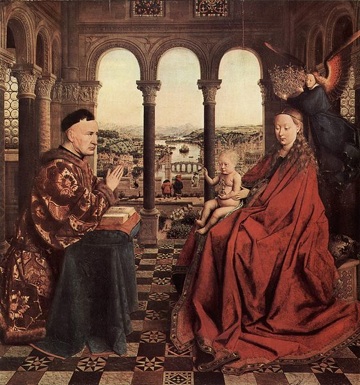 You can look at this painting on the Louvre’s website by clicking here.
You can look at this painting on the Louvre’s website by clicking here.
Let’s take a closer look at Muse in Rolin and the Arnolfini portrait - there are some differences, but the similarities outweigh them in my opinion. The way the head is posed in both paintings is similar, but Muse tilts her head down demurely with Arnolfini, and her head is a bit more in profile than in Rolin. The fleshiness to the right of Muse’s right eye in Rolin tells me she sat multiple times for this painting, and had her head positioned more frontally at one point. Look at her dimply chin and delicate upper lip, that curve right under her lower lip, and the curve of her brow from her nose. And Muse’s beautiful, actual nose is there with Arnolfini, but I think Van Eyck idealized it for Rolin - he was painting her as the Virgin Mary after all. What strikes me as so odd about Muse’s nose in the Rolin painting is that it looks like Van Eyck just didn’t bother to paint in a nostril at all. The hole is there, but it’s like her nose comes right out of her cheek - like Muse was sitting for the portrait, but Van Eyck ignored that part of her that wasn’t perfect, and thought it best to just leave the nostril out of the picture rather than make one up.
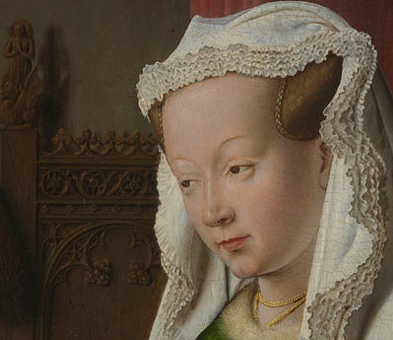
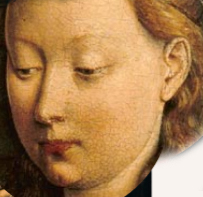 Even though the faces don’t show the same exact 3/4 view, what if I rotate the Virgin and superimpose her on the Arnolfini painting? I’ve lined up the corners of the eyes, and haven’t changed the proportions on the images at all:
Even though the faces don’t show the same exact 3/4 view, what if I rotate the Virgin and superimpose her on the Arnolfini painting? I’ve lined up the corners of the eyes, and haven’t changed the proportions on the images at all:
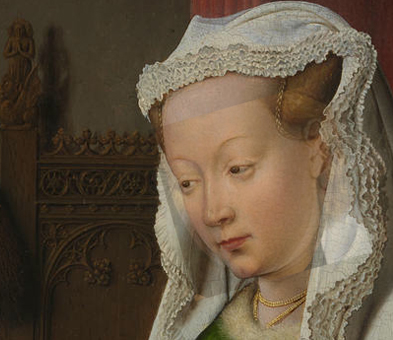 Rolin at 25% opacity on Arnolfini
Rolin at 25% opacity on Arnolfini
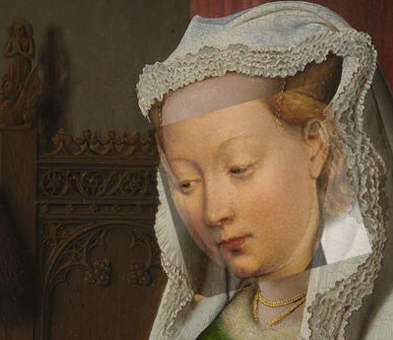 Rolin at 50% opacity on Arnolfini
Rolin at 50% opacity on Arnolfini
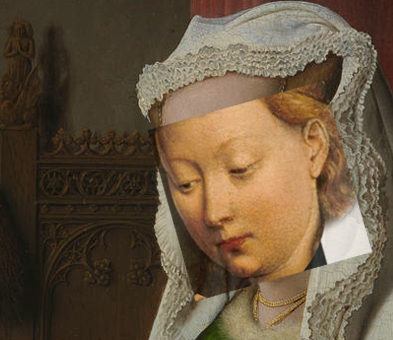 Rolin at 75% opacity on Arnolfini
Rolin at 75% opacity on Arnolfini
Note the corners of eyes, brows, brow curvature and, nose length/nostril hole placement, lip width, width and corners of mouth, rounded, convex chin and dimple, flesh under chin - they all line up. All of these proportions are the same, and I don’t think that’s coincidence; I think it’s the same model, Muse, who lent her graceful proportions and distinctive facial characteristics to this painting by sitting for the portrait with her baby.
But the thing that clinches it for me is Muse’s ear. You know how in a passport photo you need to have one of your ears showing, because it’s such a distinguishing feature? Let’s look at Muse’s ear in both the Arnolfini and the Rolin. A note- when you superimpose Muse’s face in Rolin and as a bride (above), her ears don’t line up exactly- but remember we noticed the extra fleshiness to the right of her right eye which indicates her head was posed slightly differently on different days of sitting -and likewise I think the lack of perfect alignment on her ear placement happened for the same reason. Van Eyck painted her ear where he saw it on the day he worked on it. A painter as interested in surface detail as he was would naturally paint that way.
As a bride, Muse’s ear is partially covered, but you can see the bump between her cheek and the ear canal, the way the lobe curves, and the shape and ascent in the upper part of her ear:

Here’s Muse’s ear as painted in Rolin:
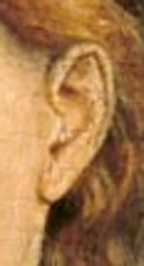
And here they are, superimposed, 50% opacity. They match up virtually identically:

Muse’s features line up in another painting very well, The Lucca Virgin from 1436. Looks like the same baby to me too- long torso, light curly locks, and compared to the size of Muse’s hand in Rolin, a tad bigger, even like he might be walking — his legs aren’t quite so chubby. You can see the whole Lucca Virgin painting here, but here’s a detail:
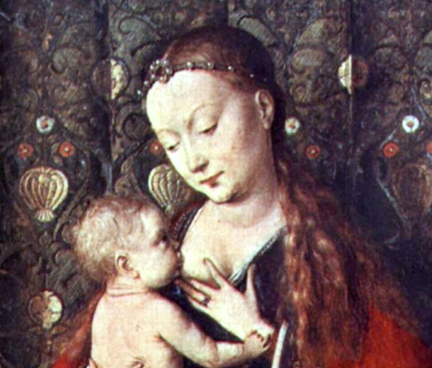
One line of thinking puts Van Eyck’s wife Margarite in the role of the model for Lucca, and I’ll grant that the proportions of Margarite’s eye width:length of nose: space between nose and chin seem to be equal to Lucca’s when the images are superimposed, except there are some important differences that lead me to believe it’s not Margarite.
Let’s look at Margarite from a detail of Van Eyck’s painting of her:
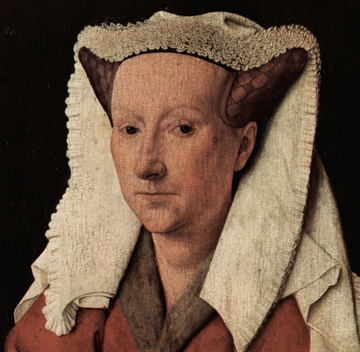 Looking above at Van Eyck’s portrait of Margarite, note the width of her mouth and how there’s no dimpling by the corners of her mouth to her cheeks, see how the corner of her mouth sags down a bit and her upper lip is quite narrow, and look at how her cheeks appear flat rather than round. Margarite’s chin is too flat, her jawline absent, and in general, she has a longer, narrower face than the Lucca Virgin. I’m sure Margarite was a lovely human being, but Van Eyck’s portrait of her represented the surface details of her face, as was his style, and the fact remains that she was plain. Muse isn’t, and neither is Lucca or the Virgin of Rolin.
Looking above at Van Eyck’s portrait of Margarite, note the width of her mouth and how there’s no dimpling by the corners of her mouth to her cheeks, see how the corner of her mouth sags down a bit and her upper lip is quite narrow, and look at how her cheeks appear flat rather than round. Margarite’s chin is too flat, her jawline absent, and in general, she has a longer, narrower face than the Lucca Virgin. I’m sure Margarite was a lovely human being, but Van Eyck’s portrait of her represented the surface details of her face, as was his style, and the fact remains that she was plain. Muse isn’t, and neither is Lucca or the Virgin of Rolin.
When Margarite is superimposed (60% Margarite) on Lucca, note how differently her brow line is from Lucca’s, and how much narrower her face:
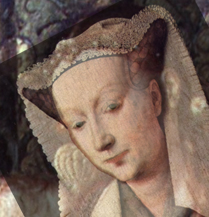
And again we have the ears - to me, Margarite’s ear and Lucca’s are so different they can’t be modeled on the same person. Margarite is missing the little flap in front of the ear canal, but it’s present on Muse’s three appearances in Van Eyck’s paintings. The cartilage in Margarite’s ear also seems to protrude a bit toward the back, and the way her ear ascends and folds over on the top is more angular than Lucca’s.


Instead, Let’s put Lucca on Muse Arnolfini (50% opacity):
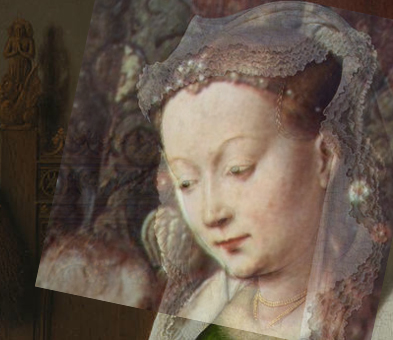 Notice the curve of the brow, and also how the curve near the temple from the corner of the left eye to the end of the left eyebrow are identical to Muse’s in Arnolfini, and how her nose, mouth, and rounder chin with dimple also match up in the same places. This wasn’t Margarite’s face. And the two ears? Not only are they in exactly the same place on the head - the structure looks like exactly the same ear.
Notice the curve of the brow, and also how the curve near the temple from the corner of the left eye to the end of the left eyebrow are identical to Muse’s in Arnolfini, and how her nose, mouth, and rounder chin with dimple also match up in the same places. This wasn’t Margarite’s face. And the two ears? Not only are they in exactly the same place on the head - the structure looks like exactly the same ear.
Finally, you might be interested to see Muse all three times, superimposed at 33% opacity, with Arnolfini, in Rolin, and as Lucca.
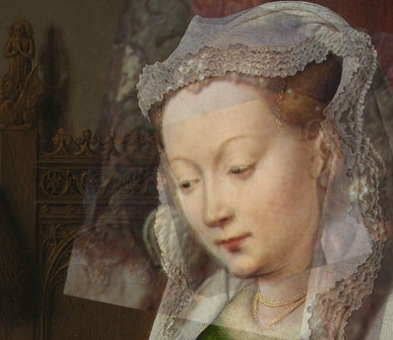 Someday I may be able to see all these paintings in person and take high resolution photographs to really put my theory to the test. Until then, I remain grateful that the web gives us such a good peek at paintings from around the world.
Someday I may be able to see all these paintings in person and take high resolution photographs to really put my theory to the test. Until then, I remain grateful that the web gives us such a good peek at paintings from around the world.